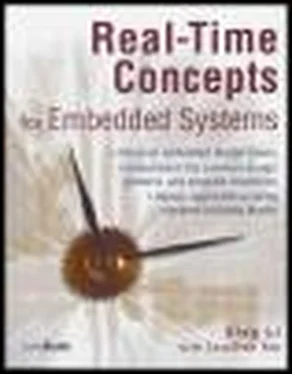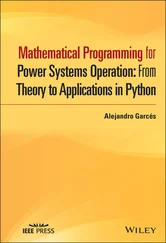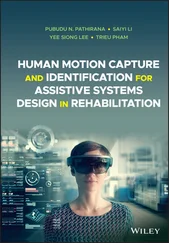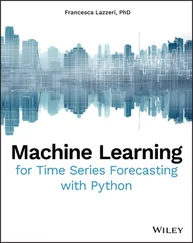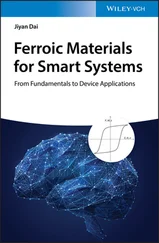Deadlocks can involve more than two tasks.
As shown in Figure 16.2, task T1 currently holds resource R1 (a printer), and T1 wants resource R2 (a scanner). Task T2 holds resource R2 and wants resource R3 (a memory buffer). Similarly, task T3 holds resource R3 and wants resource R1. It is easy to see the cycle, i.e., the circular-wait condition in this system. Tasks T1, T2, and T3, and resources R1, R2, and R3 comprise the deadlocked set. Note that in the system in Figure 16.2, one instance per resource type exists, i.e., there is one instance of R1, one instance of R2, and one instance of R3. A later section, 'Multi-Instance Resource Deadlock Detection' on page 266, discusses deadlock situations that involve multiple instances of a resource type.
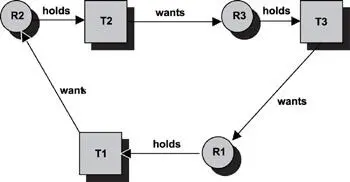
Figure 16.2: Deadlock situation among three tasks.
In this example, each task requires a single instance of a single resource type at any given time. Many situations exist in which a task might require multiple instances of multiple types of resources. The formation of deadlocks depends on how a task requests resources (formally known as a resource request model) . The deadlock detection algorithms are constructed according to the resource request models.
16.3.1 Resource Request Models
When tasks ask for resources, the way the task makes the requests can be classified into these request models:
· the Single resource request model,
· the AND resource request model,
· the OR resource request model, and
· the AND-OR resource request model.
In the Single resource request model, exemplified in both Figure 16.1 and Figure 16.2, a task can have at most one outstanding resource request at any given time. In the request model, a task asks for resources as in 'wants a printer.'
In the AND resource request model, a task can have multiple simultaneous requests outstanding at any given time. For example, a task can request resources as (R1 and R2) or (R1 and R2 and R3). A task is blocked until all of the requested resources are granted. In this request model, a task asks for resources as in "wants both a printer and a scanner." The task resumes execution only when it successfully acquires both the printer and the scanner.
In the OR resource request model, a task can request a set of resources, but the task can resume execution as soon as any one of the resources from the request set becomes available. For example, a task can request resources as (R1 or R2) or (R1 or R2 or R3). In this request model, a task asks for resources as in "wants either a printer or a scanner." The task resumes execution when it acquires either the printer or the scanner.
In the AND-OR resource request model, a task can make resource requests in any combination of the AND and OR models. For example, a task can request a set of resources as (R1 or R2 and (R3 or R4)). In this request model, the task asks for resources as in "wants either a printer or a scanner, and wants either a memory buffer or a message queue." The task can resume execution when it acquires both the printer and the memory buffer, when it acquires both the printer and the message queue, when it acquires the scanner and the memory buffer, or when it acquires the scanner and the message queue. A generalization of the AND-OR model is the C(n,k) model. In this model, a task can make n resource requests and can resume execution as soon as k resources are granted, where k ≤ n .
16.3.2 Deadlock Detection
A deadlock condition is called a stable deadlock when no task in the deadlocked set expects a timeout or an abort that can eliminate the deadlock. A stable deadlock is permanent and requires external influence to eliminate. The external influence is the deadlock detection and recovery by the underlying RTOS.
Deadlock detection is the periodic deployment of an algorithm by the RTOS. The algorithm examines the current resource allocation state and pending resource requests to determine whether deadlock exists in the system, and if so, which tasks and resources are involved.
The deadlock detection algorithm that the RTOS deploys is a global algorithm because it is used to detect deadlocks in the entire system. In general, each task of the deadlocked set is not aware of the deadlock condition. As a result, the recovery algorithm is more intrusive on the normal execution of the tasks belonging to the deadlocked set. The recovery algorithms and reasons why these algorithms are intrusive on the execution of the tasks involved in the deadlock are discussed shortly.
A temporal deadlock is a temporary deadlock situation in which one or more tasks of the deadlocked set either times out or aborts abnormally due to timing constraints. When the task times out or aborts, it frees the resources that might have caused the deadlock in the first place, thus eliminating the deadlock. This form of detection and recovery is localized to an individual task, and the task has deadlock awareness.
A system that is capable of deadlock detection is more efficient in terms of resource utilization when compared to a system without deadlock detection. A system capable of deadlock detection is not conservative when granting resource allocation requests if deadlock is allowed to occur. Therefore, resources are highly utilized. A system without deadlock detection is conservative when granting resource allocation requests. A resource request is denied if the system believes there is a potential for deadlock, which may never occur. The conservatism of the system results in idle resources even when these resources could be used.
Deadlock detection does not solve the problem; instead, the detection algorithm informs the recovery algorithm when the existence of deadlock is discovered.
For deadlock in the Single resource request model, a cycle in the resource graph is a necessary and sufficient condition.
For deadlock in the AND resource request model, a cycle in the resource graph is a necessary and sufficient condition. It is possible for a task to be involved in multiple deadlocked sets.
For deadlock in the OR request model, a knot is a necessary and sufficient condition.
Therefore, deadlock detection involves finding the presence of a cycle in the resource graph for both the Single and the AND resource request models. Deadlock detection involves finding the presence of a knot in the resource graph for the OR resource request model.
For deadlock in the AND-OR model, no simple way exists of describing it. Generally, the presence of a knot after applying the algorithm to the OR model first and then subsequently applying the algorithm to the AND model and finding a cycle is an indication that deadlock is present.
The following sections present two deadlock detection algorithms-one for the single resource request model and one for the AND resource request model-to illustrate deadlock detection in practice.
For node A in the resource graph, the reachable set of A is the set of all nodes B , such that a directed path exists from A to B . A knot is the request set K , such that the reachable set of each node of K is exactly K .
Single-Instance Resource Deadlock Detection
The deadlock detection algorithm for systems with a single instance of each resource type, and tasks making resource requests following the single resource request model, is based on the graph theory. The idea is to find cycles in the resource allocation graph, which represents the circular-wait condition, indicating the existence of deadlocks.
Читать дальше
